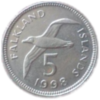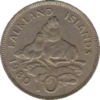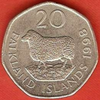Falkland Islands pound
| ISO 4217 | |
|---|---|
| Code | FKP (numeric: 238) |
| Subunit | 0.01 |
| Unit | |
| Plural | |
| Symbol | £ |
| Denominations | |
| Subunit | |
| 1⁄100 | penny |
| Plural | |
| penny | pence |
| Symbol | |
| penny | p |
| Banknotes | £5, £10, £20, £50 |
| Coins | 1p, 2p, 5p, 10p, 20p, 50p, £1, £2 |
| Demographics | |
| User(s) | alongside sterling alongside sterling |
| Issuance | |
| Government | Government of the Falkland Islands |
| Website | www |
| Valuation | |
| Inflation | 3.6% |
| Source | The World Factbook, 1998 |
| Pegged with | pound sterling at par |
The pound is the currency of the Falkland Islands, a British Overseas Territory in the South Atlantic Ocean. The symbol is the pound sign, £. The ISO 4217 currency code is FKP.
The Falkland Islands pound has always been pegged to sterling at par and banknotes of both currencies are used interchangeably on the islands, but the Falkland Island pound is not widely accepted in Britain itself.
History
[edit]The pound was introduced following the reassertion of sovereignty in the Falklands Islands by the British in 1833. Initially, sterling coin circulated, in units of a pound subdivided into 20 shillings, each of 12 pence. Specific issues of banknotes have been made for the Falkland Islands since 1899.[1] In 1971, the pound was decimalised and subdivided into 100 (new) pence. Coins have been minted specifically for the Falklands since 1974.[2]
For a more general history of currency in the South Atlantic region, see British currency in the South Atlantic and the Antarctic.
Legislative basis
[edit]In Falkland Islands law, the Currency Ordinance 1987 states that the Falkland Islands pound is the currency of the Falkland Islands,[3] and that it has parity with the pound sterling.[4]
References to 'pounds' in the Falklands Islands (such as in contracts and debts) refer to the Falkland Islands pound.[5]
Falkland Island pounds can be exchanged for sterling on demand, but the Currency Commissioners are entitled to charge a percentage fee for doing so.[6]
Coins
[edit]In 1974, 1⁄2, 1, 2, 5 and 10 pence coins were introduced. 50 pence coins were introduced in 1980, followed by 20 pence in 1982, £1 in 1987 and a circulating £2 in 2004. The halfpenny coin was last issued in 1983 and was demonetised shortly after. Smaller versions of the 5p, 10p and 50p, corresponding to the current UK issues, were issued in 1998, replacing the larger versions (which for the 5p was eight years after its introduction in the UK). The introduction of the circulation £2 coin in 2004 was six years after the same coin was issued in the UK. In 2020, the Falklands Islands issued a new 12-sided bi-metallic £1 coin, matching both the composition and size of its UK counterpart, while also announcing the withdrawal of the round £1 coin in January 2023, with the assistance of the Royal Mint. All the coins have the same composition and size as the corresponding British coins.
| £0.01 | £0.02 | £0.05 |
|---|---|---|

|

|

|
| Gentoo penguin[7] | Upland goose[7] | Black-browed albatross[7] |
| £0.10 | £0.20 | £0.50 |

|

|

|
| South American sea lion | Sheep[7] | Warrah[7] |
| £1.00 | £2.00 | £2.00 edge |

|

|
|
| Falkland Islands coat of arms[7] |
Map of the Falkland Islands |
Banknotes
[edit]Between 1899 and 1901, the government introduced notes for 5/- and 10/-, £1 and £5. 5/- notes were issued until 1916. Following decimalisation in 1971, the 10/- note of the preceding issue became the new 50-pence note, though it retained its old design.[8] £10 notes were introduced in 1975, followed by £20 in 1984 and £50 in 1990. Banknotes in circulation are:
- £5 (red)
- £10 (green)
- £20 (brown)
- £50 (blue, green and red combination)
Falkland Islands' banknotes feature the same images, differing only in their respective denominations and corresponding colours. On the front side, all notes depict a portrait of Queen Elizabeth II, the Falklands' coat of arms, a small map of the islands, and images of two of the islands' main animals: penguins and sea lions. On the back, notes feature pictures of Christ Church Cathedral in Stanley and Government House, the official residence of the governor of the Falkland Islands.
Banknotes are printed by De la Rue plc on behalf of the Falkland Island Commissioners of Currency. In 2010 an order was placed for the printing of 200,000 £10 banknotes and for 200,000 £20 banknotes which would represent a supply of banknotes that would last for 15 to 20 years.[9]
| Current FKP exchange rates | |
|---|---|
| From Google Finance: | AUD CAD CHF CNY EUR GBP HKD JPY USD ARS JPY USD |
| From Yahoo! Finance: | AUD CAD CHF CNY EUR GBP HKD JPY USD ARS JPY USD |
| From XE.com: | AUD CAD CHF CNY EUR GBP HKD JPY USD ARS JPY USD |
| From OANDA: | AUD CAD CHF CNY EUR GBP HKD JPY USD ARS JPY USD |
See also
[edit]References
[edit]- ^ "Falkland Islands". Banknote World. Retrieved 21 February 2023.
- ^ "Stamps & Coins of the Falkland Islands". The Falkland Islands Association. Retrieved 21 February 2023.
- ^ "Currency Ordinance 1987" (PDF). Section 3.
The unit of currency of the Falkland Islands shall be the Falkland Islands pound, which shall be divided into one hundred pence.
- ^ "Currency Ordinance 1987" (PDF). Section 4.
The Falkland Islands pound shall have parity with the pound sterling.
- ^ "Currency Ordinance 1987" (PDF). Section 8.
Contracts, transactions and documents in the Falkland Islands to be in Falkland Islands currency.
- ^ "Currency Ordinance 1987" (PDF). Section 12.
The Commissioners shall on demand buy or sell sterling for immediate delivery in London or the Falkland Islands against the Falkland Islands pound.
- ^ a b c d e f "Guernsey Coin List". falklandwool.com. Archived from the original on 2010-06-08. Retrieved 2010-06-23.
- ^ Linzmayer, Owen (2012). "Falkland Islands". The Banknote Book. San Francisco, CA: www.BanknoteNews.com.
- ^ "£10 and £20 Currency Notes" (PDF). Executive Council of the Falkland Islands. 19 August 2010. Archived from the original (PDF) on March 8, 2012. Retrieved 2010-09-03.
- Krause, Chester L.; Clifford Mishler (1991). Standard Catalog of World Coins: 1801–1991 (18th ed.). Krause Publications. ISBN 0873411501.
- Pick, Albert (1994). Standard Catalog of World Paper Money: General Issues. Colin R. Bruce II and Neil Shafer (editors) (7th ed.). Krause Publications. ISBN 0-87341-207-9.
